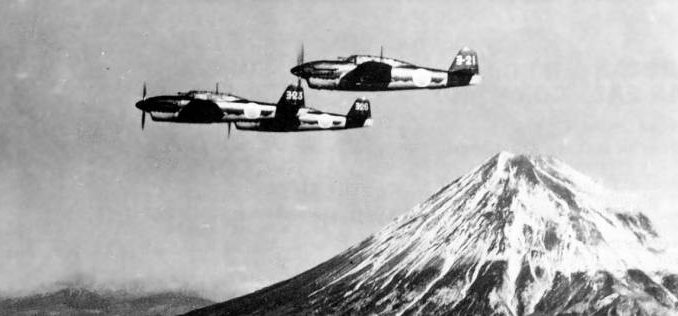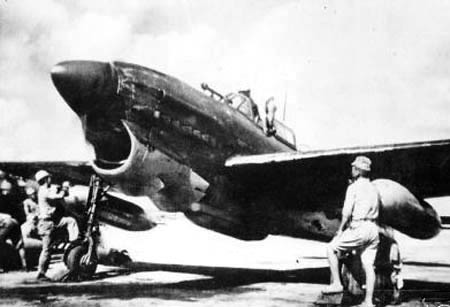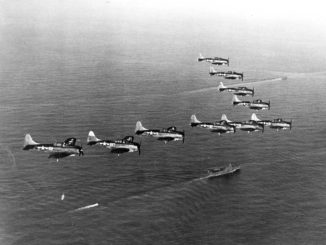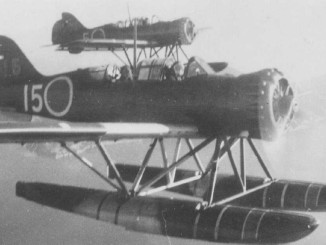
In 1938 Japan acquired one of the prototype Heinkel He 118 dive bombers that the Luftwaffe had rejected in favour of the Junkers Ju 87. Although this aircraft crashed during trials, its overall performance had been so impressive that the Yokosuka Naval Air Technical Arsenal was ordered to design a new dive bomber inspired by the He 118 for the 13-Shi requirement issued by the Navy. The resulting design was a remarkably aerodynamic aircraft designated the Yokosuka D4Y.
Japan licensed the Daimler-Benz DB 601A engine, which was produced in Japan as the Aichi Atsuta V12, and fitted it to the initial models of the D4Y. The Atsuta was one of very few inline liquid-cooled engines used by the Japanese during the war, and it would prove difficult for poorly trained maintenance units to deal with. The D4Y’s fuselage was a very clean design, featuring retractable landing gear and an internal bomb bay, both features lacking from the preceding D3A Type 99.
Early dive bombing tests revealed flaws in the construction which resulted in cracks in the wings, so initially the aircraft was used only in the reconnaissance role. Two of the five D4Y prototypes were converted into D4Y1-C reconnaissance models and assigned to the carrier Soryu just before she departed for the Battle of Midway. These flew a few sorties before the carrier was sunk and both aircraft were lost. Further production was slow and through to March 1943 only 25 aircraft had been delivered.
At this time improvements to the wing spars had finally resulted in a usable dive bomber, and the type slowly began to replace the D3A Type 99 in front-line service. At about the same time the D4Y was re-engined, the inline Atsuta engine proving difficult for maintenance units to manage. The Mitsubishi Kinsei, a well-known quantity in the fleet, proved a suitable replacement and all late model Suisei bombers were so equipped.
Unfortunately the D4Y design attained true maturity just as the Americans were beginning to dominate the naval air war in the Pacific. At the Battle of the Philippine Sea, scores of D4Ys were lost to American fighters directed by ship-borne radar, and off the Philippines and Okinawa even more of the bombers were lost in futile attacks on the US Navy. The greatest success of the D4Y came in March 1945. Over two days D4Ys attacked American carriers operating off the Home Islands, damaging the Enterprise, Yorktown, Wasp and Franklin, the latter so badly that she had to retire to the United States for repairs and did not return to service until the war had ended.
Facing relentless bombing attacks by B-29 bombers which began to attack Jaanese cities in force in the spring of 1945, the Japanese began to convert several aircraft into night fighters. Amongst these were later variants of the D4Y, which had relatively good performance and stood a chance of challenging the enormous Boeing bombers. Several were fitted with upward-firing cannons that in theory allowed D4Ys to sneak underneath the American bomber streams and shoot down B-29s, but in practice this was a difficult manoeuvre and aircraft so fitted had little appreciable effect on the waves of bombers.
In 1943 the Allied Air Intelligence Unit assigned the Suisei the codename “Judy”.
Yokosuka D4Y Type 2 Specifications
| Yokosuka D4Y1 Suisei | |
| Role | Dive bomber |
| Crew | 2: Pilot, gunner |
| Powerplant | 1x Aichi Atsuta 12 (1,010hp) |
| Speed | 343mph (max) |
| Ceiling | 32,480ft |
| Range | 978 miles (internal) |
| Armament | 2x Type 97 7.7mm Machine Gun 1x Type 98 7.92mm Machine gun |
| Ordnance | |
| Dimensions | 33ft 6in (length) 37ft 9in (wingspan) 12ft 3in (height) |
| Wing Area | 254 sq.ft. |
| Weight | 5,379lb (empty) 8,047lb (gross) |
| Number produced | 660 |
| Yokosuka D4Y1-C Suisei | |
| Role | Carrier Reconnaissance |
| Crew | 2: Pilot, gunner |
| Powerplant | 1x Aichi Atsuta 12 (1,010hp) |
| Speed | 332mph (max) |
| Ceiling | 29,500ft |
| Range | 944 miles (internal) |
| Armament | 2x Type 97 7.7mm Machine Gun 1x Type 1 7.92mm machine gun |
| Ordnance | |
| Dimensions | 33ft 6in (length) 37ft 9in (wingspan) 12ft 3in (height) |
| Wing Area | 254 sq.ft. |
| Weight | 5,379lb (empty) 8,047lb (gross) |
| Yokosuka D4Y2 Suisei | |
| Role | Dive bomber |
| Crew | 2: Pilot, gunner |
| Powerplant | 1x Aichi Atsuta 32 (1,340hp) |
| Speed | 360mph (max) |
| Ceiling | 35,105ft |
| Range | 944 miles (internal) |
| Armament | 2x Type 97 7.7mm Machine Gun 1x Type 1 7.92mm machine gun |
| Ordnance | 1,235lb bombs |
| Dimensions | 33ft 6in (length) 37ft 9in (wingspan) 12ft 3in (height) |
| Wing Area | 254 sq.ft. |
| Weight | 5,809lb (empty) 8,455lb (gross) |
| Number produced | 326 |
| Yokosuka D4Y2-S Suisei | |
| Role | Night fighter |
| Crew | |
| Powerplant | 1x Aichi Atsuta 32 (1,340hp) |
| Speed | |
| Ceiling | 0ft |
| Range | |
| Armament | |
| Ordnance | |
| Dimensions | 33ft 6in (length) 37ft 9in (wingspan) 12ft 3in (height) |
| Weight | |
| Yokosuka D4Y3 Suisei | |
| Role | Carrier Bomber |
| Crew | |
| Powerplant | 1x Mitsubishi Kinsei 62 (1,560hp) |
| Speed | 357mph (max) |
| Ceiling | 34,450ft |
| Range | 820 miles (internal) |
| Armament | |
| Ordnance | |
| Dimensions | 0ft 0in (length) 0ft 0in (wingspan) 0ft 0in (height) |
| Weight | 5,514lb (empty) 8,276lb (gross) |
| Number produced | 536 |
| Yokosuka D4Y4 Suisei | |
| Role | Carrier Bomber |
| Crew | 1 |
| Powerplant | 1x Mitsubishi Kinsei 62 (1,560hp) |
| Speed | 350mph (max) |
| Ceiling | 27,725ft |
| Range | 890 miles (internal) |
| Armament | |
| Ordnance | |
| Dimensions | 0ft 0in (length) 0ft 0in (wingspan) 0ft 0in (height) |
| Weight | 5,809lb (empty) 10,013lb (gross) |
| Number produced | 296 |





Leave a Reply